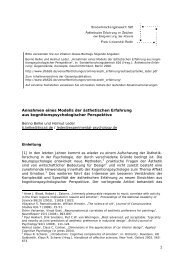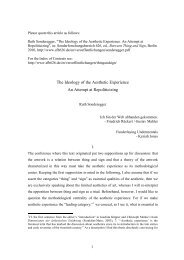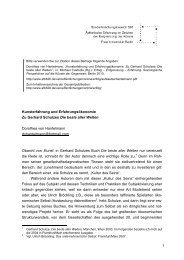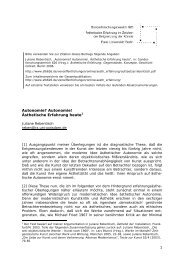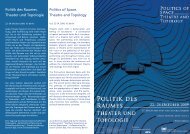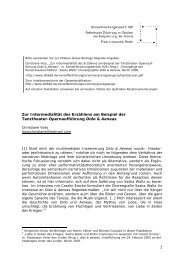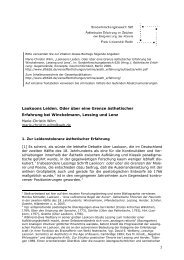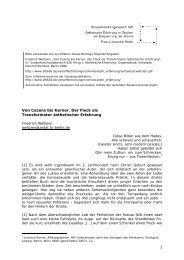Retracing Modernist Praxis: Richard Shiff
Retracing Modernist Praxis: Richard Shiff
Retracing Modernist Praxis: Richard Shiff
Create successful ePaper yourself
Turn your PDF publications into a flip-book with our unique Google optimized e-Paper software.
Please quote this article as follows:<br />
Michael Lüthy, "<strong>Retracing</strong> <strong>Modernist</strong> <strong>Praxis</strong>: <strong>Richard</strong> <strong>Shiff</strong>", in:<br />
Sonderforschungsbereich 626, ed., Between Thing and Sign, Berlin 2010,<br />
http://www.sfb626.de/en/veroeffentlichungen/luethy.pdf<br />
For the index of contents see:<br />
http://www.sfb626.de/en/veroeffentlichungen/thingandsign/<br />
<strong>Retracing</strong> <strong>Modernist</strong> <strong>Praxis</strong>: <strong>Richard</strong> <strong>Shiff</strong><br />
Michael Lüthy<br />
My emphasis is very much on processes of making – techniques. Accordingly, by<br />
representation I refer to an act of depiction, both (iconic) figuration and (symbolic)<br />
configuration. I do not use the term representation to signify the adequation of representation,<br />
that is, some second presentation bearing the full ‘presence’ of the<br />
original. The nineteenth-century sources whom I cite seem very much aware that<br />
representations may at times seek to approach re-presentation, but do not attain that<br />
end. 1<br />
This quotation from an early article of <strong>Richard</strong> <strong>Shiff</strong>’s delineates his area of research very<br />
precisely. The “act of depicting” around which the (in the interim) numerous studies<br />
circle is investigated within the time-frame of a Modernism that, beginning in the early<br />
nineteenth century, undertook replacing the old conceptions of artistic practice – for<br />
example, the theory of mimesis – with new ones. At the center of these revisions stood<br />
rather less the relationship between original and copy, as in the case of mimetic theory,<br />
but much more the procedure which occurred involving artist, the chosen medium of<br />
representation, and the object to be represented – a procedure whose many-layered and<br />
1 <strong>Richard</strong> <strong>Shiff</strong>, “Representation, Copying, and the Technique of Originality”, in New Literary History<br />
(issue 15/ Winter 1984), 333-63, quote 333. This article should be read in parallel with a second one, which<br />
illuminates the same area from another direction: <strong>Richard</strong> <strong>Shiff</strong>, “The Original, the Imitation, the Copy, and<br />
the Spontaneous Classic: Theory and Painting in Nineteenth-Century France”, in Yale French Studies<br />
(issue 66/ 1984), 27-54.<br />
1
process-related nature had occasionally so distinctly advanced that it appeared to become<br />
the artwork’s actual content. <strong>Shiff</strong> devotes his attention, in short, to representation after<br />
the end of classical representation.<br />
In this process, two things continually remain in view: artistic praxis, that is “making”<br />
with its respective techniques; and at the same time the now-anticipated, now-fulfilling<br />
theory running parallel, which frames and reflects the praxis but is in turn re-oriented by<br />
it. <strong>Shiff</strong> emphasizes the rhetorical character of both levels: not only the theory, which<br />
attempted to shift art into a particular light, but also the praxis, which in Modernism<br />
aimed at representing the process of representation at the same time – that is, to display<br />
how decisively what is represented is shaped by the medium’s singularity and the specific<br />
artistic techniques. Precisely the direct, unmediated, and authentic procedures which<br />
artists willingly subscribe to since the anti-academic turning-point of Modernism are<br />
rhetorical, to the extent that they stage directness and authenticity as an effect. It has to do<br />
in each case, according to <strong>Shiff</strong>, with the paradox of a represented immediacy.<br />
While the early texts devote themselves rather to the theoretical discourses of especially<br />
the nineteenth century, his more recent ones turn increasingly to the inter-relation<br />
between artist and medium. In a “close reading” of the material pictorial surface as the<br />
trace of making, they delineate the singularity of respective representational acts. It is that<br />
“contact” of artist and medium within the artwork that <strong>Shiff</strong> means with “the physicality<br />
of picturing”. Yet the analyses of works also make clear how little theory and practice<br />
can be separated in Modernism, which was to be so strongly characterized by programs<br />
and concepts. For certain essential terms of <strong>Modernist</strong> discourse – for example,<br />
originality, abstraction, materialization, or embodiment – again and again come into play<br />
without fail, in that the works appear to thematize precisely these terms and concepts.<br />
Conversely, that rather discourse-theoretically oriented article from which the opening<br />
quote derived develops a central problem of <strong>Modernist</strong> praxis. The artists of Modernism<br />
find themselves confronting the difficulty, according to <strong>Shiff</strong>, of on the one hand<br />
generating works that are indebted to authentic and singular expression, but on the other<br />
of developing a style that clearly identifies their own works as Monets, Picassos, or<br />
2
Lichtensteins. They confront the task of inventing a handwriting that is immediate, and<br />
nonetheless remains repeatable from work to work. <strong>Shiff</strong> found an exceedingly<br />
impressive formulation for this contradiction. What the artists must achieve is a<br />
“technique of originality”. In Modernism, this takes the place of the old techniques of<br />
representation learned in the course of artistic training – chiaroscuro, the carefully distinct<br />
stages in the working process between first sketch and concluding varnish, the calculated<br />
reference to earlier masters, and so forth.<br />
In the article under consideration here, this problematic comes to light in the discussion<br />
of Georges Seurat’s pointillist screen of dots, which Seurat described on the one hand as<br />
his personal style and on the other as a mere procedure used. Seurat resolves that problem<br />
prepared in advance by <strong>Shiff</strong>, in that he developed a de-subjectivized neutral painting<br />
procedure, whose inventor he praised himself as, to which repeatability was nonetheless<br />
ascribed from the beginning. Seurat was not alone in his solution. Many artists of<br />
Modernism secured their individual recognizability essentially through the choice of a<br />
medium that precisely disavowed the quality of handwriting, in order to permit itself to<br />
be all the more multifariously made use of. One might think for example of Yves Klein’s<br />
“International Klein Blue”, with which he covered pictorial surfaces and objects of very<br />
diverse natures; of Warhol’s silkscreen, which appeared to be suited to everything, and<br />
possessed the capacity to transform everything into a “Warhol”; or the white linear cubes<br />
of Sol LeWitt, which allow themselves to be organized into ever-new structures. <strong>Shiff</strong><br />
pursues the psychological basis for efforts in the direction of a simultaneously individual<br />
and impersonal “look” in a variety of more recent texts, 2 and his conjecture has it that the<br />
artists are seeking in this way to avoid three things: first, the clichés about artistic selfexpression<br />
existing since the aesthetic of genius; second, the ideological positional<br />
reference compelling them to struggle for the “right” Modernism; and third, the<br />
illustration of their own personality, to the extent that it could be considered to be socially<br />
2 See especially <strong>Richard</strong> <strong>Shiff</strong>, “Puppet and Test Pattern: Mechanicity and Materiality in Modern Pictorial<br />
Representation”, in Bruce Clarke and Linda Dalrymple Henderson, ed., From Energy to Information:<br />
Representation in Science and Technology, Art, and Literature, (Stanford, 2002), 327-50 and 420-26.<br />
3
and culturally shaped. With the paradoxical effect of an impersonal handwriting,<br />
according to <strong>Shiff</strong>, one tried to save the “actual” personality from societal finish and<br />
stylistic pigeonholing.<br />
<strong>Shiff</strong> grouped his early studies of this complex of themes within exemplary investigations<br />
of Cézanne’s working process, which work their way through what the artist understood<br />
with his favorite term “réalisation”. 3 In his pictures, Cézanne attempted at any given<br />
time to realize many things at once: first of all, the motif (for example, Mont Sainte-<br />
Victoire) in its endless multiplicity; further, the feelings that the motif released in the<br />
artist; and finally, the concrete painting itself, whose generation could first bring the other<br />
“realizations” – that of the motif, and that of feelings – to light. The “process of making”<br />
meant for Cézanne allowing the opposed movements of recording a sensory impression<br />
and the depositing of paint on a canvas, the “impression” and the “expression”, to merge<br />
into a single gesture. Cézanne’s patchy non-focus can be grasped as that technique<br />
permitting the painter to impress the individual marks on the canvas with that decisive<br />
semantic ambivalence between iconic reference to the motif, and indexical reference back<br />
to the painter. The tensions within the aesthetic object result from this multi-layered,<br />
legible working process. They express themselves as ambivalences of the painted surface<br />
– between seeing and touching, flatness and depth, materiality of the paint medium and<br />
immateriality of the pictorial effect. Moreover, it is not only the tensions on the subjector<br />
object-side of art that <strong>Shiff</strong> investigates, but above all the metonymic transfers which<br />
take place between them. They make it possible for tensions within the image to stand in<br />
for tensions within the working process or in the artist’s subjectivity, for example in that<br />
the image is understood as anthropomorphized and the canvas is grasped as a skin, which<br />
like human skin possesses the ability to breathe. In this fashion, <strong>Shiff</strong> distinguishes<br />
precisely between what a picture is, and what it is supposed to produce as an effect – a<br />
distinction that is immediately connected with that between thing and sign. For as <strong>Shiff</strong>’s<br />
already mentioned remarks about the “technique of originality” demonstrate, an artwork<br />
3 <strong>Richard</strong> <strong>Shiff</strong>, Cézanne and the End of Impressionism: A Study of the Theory, Technique, and Critical<br />
Evaluation of Modern Art (Chicago, 1984).<br />
4
is not simply original or not original; what is much more decisive is whether it is capable<br />
of producing originality as an effect, for example by means of a skillful staging of<br />
indexicality. The modern artist is, according to <strong>Shiff</strong>, a master of that metonymic transfer<br />
which shifts a sign or an action from one context into another. It is these metonymic<br />
transfers that can lead, for example, to the artwork’s materiality standing in for the<br />
corporeality of a person, or – to take up the example of Seurat again – that seeing and<br />
touching alternatingly refer to one another. Seurat achieved this in that he transposed<br />
seeing into a series of point-like touches on the canvas, which transform themselves back<br />
into the viewer’s perception, as if it does not have to do with painted dots but rather on<br />
the contrary with flickering light.<br />
A final tension within the artworks discussed by <strong>Shiff</strong> should be adressed here, namely<br />
that between the materiality and the mediality of the image. In this connection, it seems to<br />
have to do with a difference that has an historical dimension. In relation to Chuck Close’s<br />
portraits, <strong>Shiff</strong> speaks of their presenting the image as well as at the same time “the things<br />
out of which it is made” (in the original, “the stuff”). This sturdy expression – “stuff” –<br />
surprises one, for it accentuates the materiality of the image in a very specific way.<br />
“Stuff” is, according to his interpretation, oppositional, frequently untidy, perhaps even<br />
dirty, but nonetheless close and important to oneself, as is apparent in the expression “my<br />
stuff”. “Stuff” exhibits precisely not that abstract immateriality of the medium which<br />
present-day media theory presupposes, when it emphasizes the media- and sign-based<br />
nature of our communication. A specific aspect of artistic Modernism could possibly lie<br />
in the significance of “stuff” for the working process, which would have in the interim<br />
become a bygone. The mediality of art, ranging from Delacroix up until the Abstract<br />
Expressionists – that is, the time-frame <strong>Shiff</strong> devotes his attention to – is grasped very<br />
materially and like a “thing”. That is also still valid for Chuck Close, whom <strong>Shiff</strong> indeed<br />
brings into relation with the phenomenon of digitalization and the generation of new<br />
technologies like television or the computer, who nevertheless translates the experience<br />
of them back into the old medium of oil painting. With the widespread entry into art of<br />
the so-called “media”, which are themselves now employed as a working medium,<br />
5
materiality and mediality appear to increasingly move away from one another. But what,<br />
if the diagnosis is correct, does this mean for the metonymic transfer that <strong>Shiff</strong> elaborates<br />
upon, especially for the exchange relationship between the materiality of the artwork and<br />
the corporeality of the artist? What happens to the “physicality of picturing” under these<br />
different conditions? The answer to this would be studies which continued the line that<br />
<strong>Shiff</strong> draws, extending it from the early nineteenth century through the 1960s, into our<br />
present time. They would have to evaluate the still-unclear consequences that the dematerialization<br />
and digitalization of media have for the production and experiencing of<br />
art. The precision with which <strong>Richard</strong> <strong>Shiff</strong> analyzes works and the discourse<br />
accompanying them would be desired of the discussion of this just now beginning.<br />
Translated from the German by Julia Bernard<br />
6



